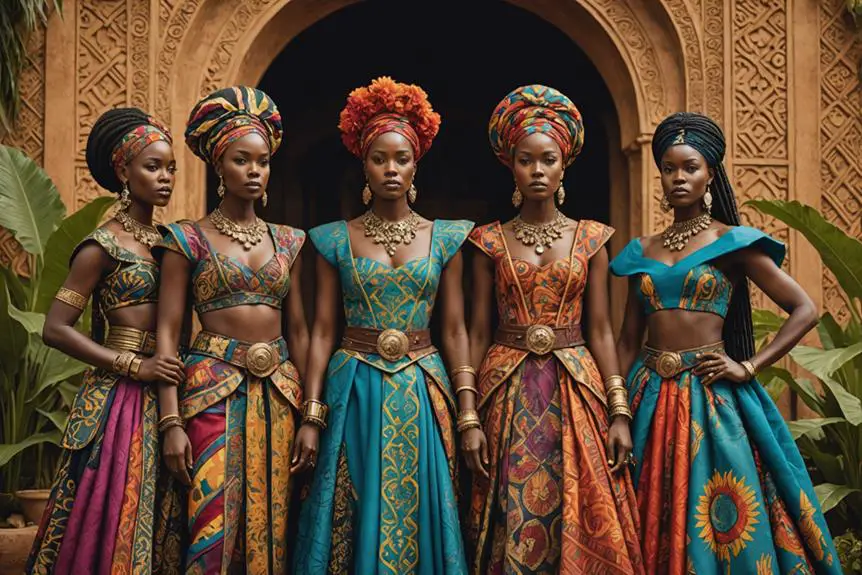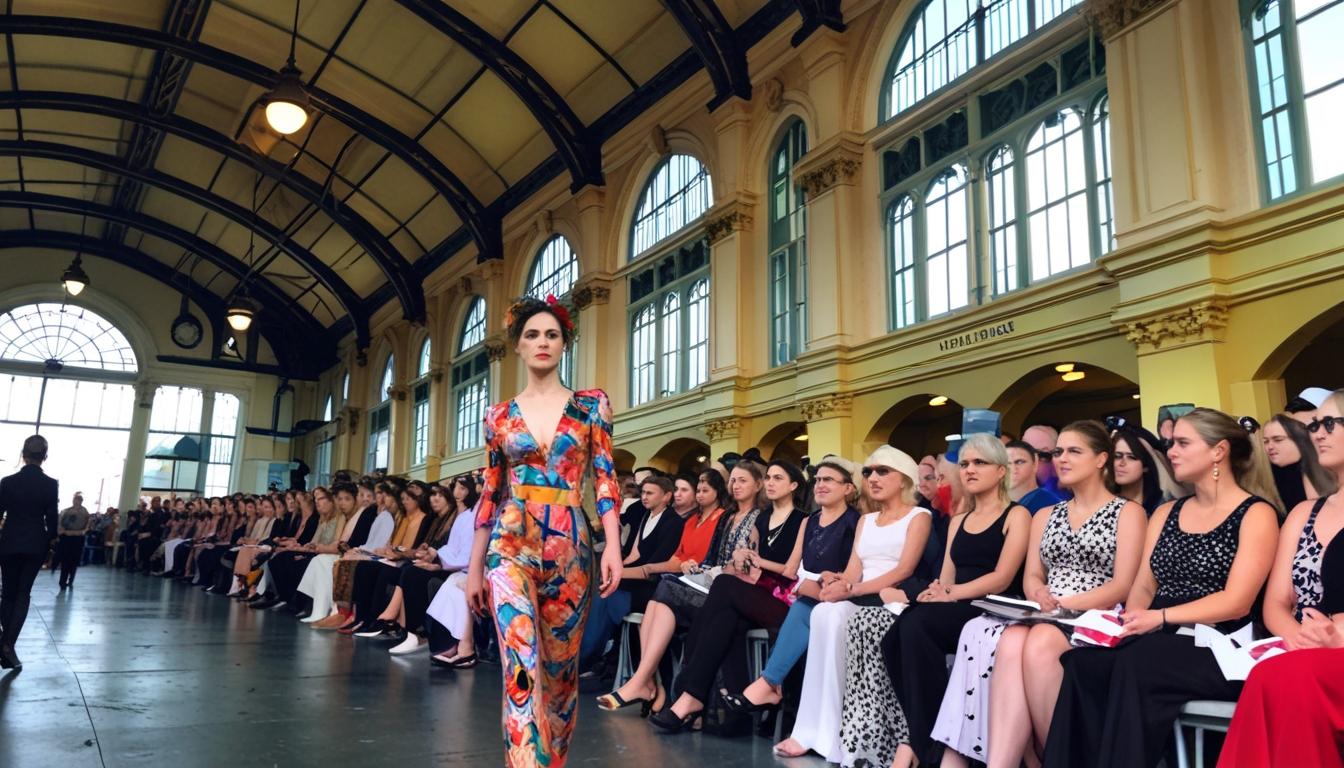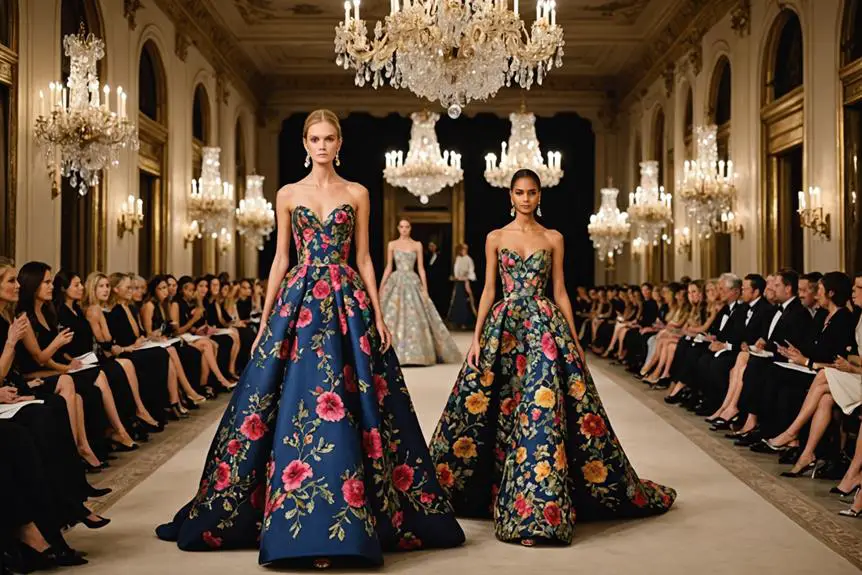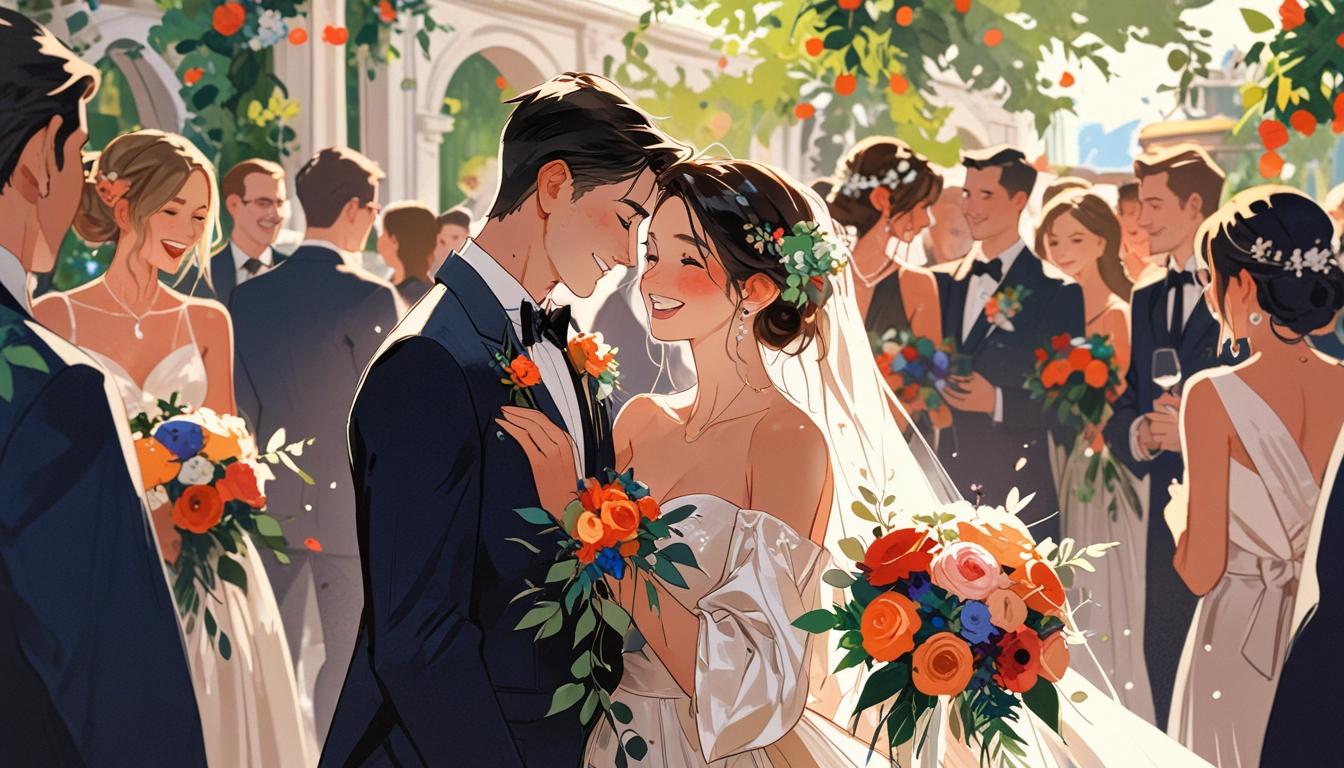You might think that costumes in a film are just superficial elements, but in "The Woman King," they're essential to understanding the characters and themes. The outfits not only reflect 19th-century West African culture but also convey the emotional journeys of the characters. Consider how General Nanisca's garments contrast with Nawi's evolving style, each choice meticulously crafted to enhance storytelling. What might these visual choices reveal about empowerment and identity, and how do they resonate with the audience?
Film Overview and Context
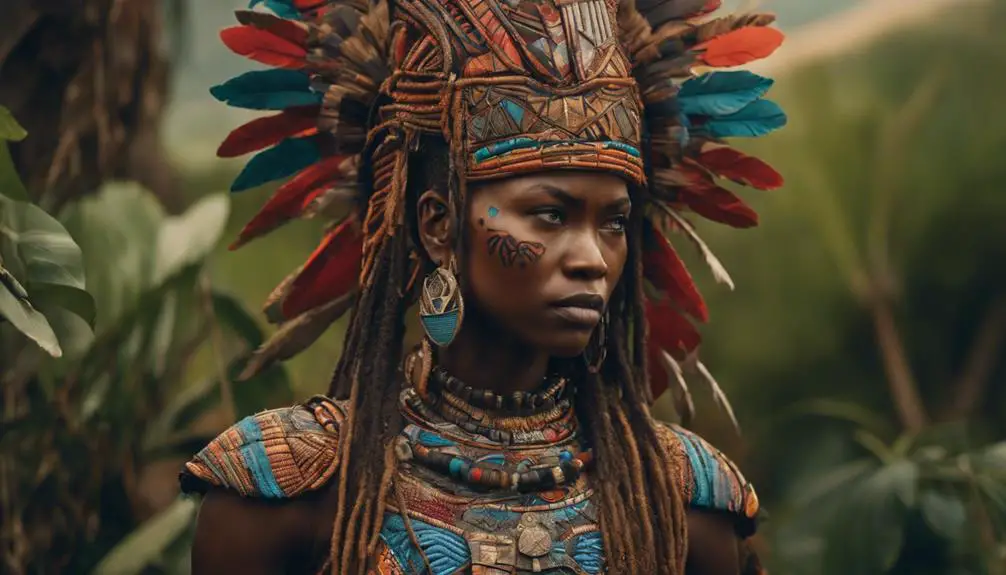
"The Woman King," directed by Gina Prince-Bythewood, is a compelling historical action drama that premiered on September 16, 2022. It focuses on the Agojie, a fierce group of female warriors from the Kingdom of Dahomey in the 19th century. This film not only showcases the incredible strength and resilience of women but also aims to challenge the stereotypes often associated with African women in cinema. You'll find yourself immersed in a narrative that highlights the significant contributions of the Agojie, offering a rejuvenating perspective on female empowerment and cultural pride.
The film explores themes of gender roles in warfare, presenting a rich tapestry of African history and heritage. With costumes designed by Gersha Phillips, the visual storytelling elevates the film's historical context, making the Agojie's journey even more impactful. As you watch, you'll appreciate how "The Woman King" serves as a cultural storytelling vehicle, sparking conversations about historical accuracy and representation in film. By shining a light on the complexities of these women's lives, it encourages a deeper understanding of their pivotal roles in history, making this film a must-see for anyone interested in powerful narratives.
Main Cast and Characters
In "The Woman King," each character's costume plays an essential role in showcasing their significance and status within the story. You'll notice how Viola Davis's General Nanisca dons warrior attire that radiates strength, while Thuso Mbedu's Nawi shifts from traditional garments to a more prominent warrior look, highlighting her growth. The symbolism in these outfits not only represents their individual journeys but also emphasizes the hierarchy and unity among the Agojie, making the visuals as compelling as the narrative itself.
Character Costume Significance
Exploring the character costume significance in "The Woman King" reveals how each outfit powerfully reflects the identity and status of its wearer. Costume designer Gersha Phillips masterfully uses clothing to convey critical elements of each character's role and background.
- General Nanisca, played by Viola Davis, dazzles in elaborate costumes adorned with gold embroidery and cowrie shells, symbolizing her high rank and victories in battle.
- Thuso Mbedu's character, Nawi, sports simpler garments crafted from special strip-weave fabric, illustrating her journey as an aspiring warrior within the Agojie.
- Lashana Lynch's Izogie wears warrior attire that emphasizes her strength and resilience, aligning perfectly with her fierce role among the Agojie.
Additionally, Sheila Atim's Amenza showcases traditional patterns that highlight the rich cultural heritage of the Dahomey Kingdom, while John Boyega's King Ghezo dons regal attire with metallic embroidery, signifying his royal authority. Each of these costumes in "The Woman King" not only enhances the visual storytelling but also deepens the audience's understanding of the characters, making their journeys all the more enchanting.
Symbolism in Attire
Costumes in "The Woman King" are rich with symbolism, directly reflecting the characters' identities and societal roles. Viola Davis, portraying General Nanisca, dons elaborate gold embroidery that signifies her leadership among the Agojie warriors, setting her apart as a figure of strength and authority. Each character, like Thuso Mbedu's Nawi, carries unique talismans and symbols etched into their cross belts, embodying personal beliefs and protective energies that enhance their individual identities. Nawi's simple two-yard wrap, crafted from special strip-weave fabric, highlights her status as an aspiring warrior, contrasting beautifully with the intricate designs of seasoned fighters.
King Ghezo's attire further emphasizes his authority, adorned with regal metallic embroidery and a cream palace outfit repurposed from an Ethiopian bedsheet. This not only showcases his sophistication but also reinforces his role as the ruler of Dahomey. The cowry shells woven into various characters' costumes symbolize victory and serve as gifts from the king, underlining the cultural heritage and significance of the Agojie warriors. Each thread tells a story, making the costumes not just clothing, but powerful representations of identity and tradition within this remarkable film.
Representation of Hierarchy
Hierarchy among the characters in "The Woman King" is vividly illustrated through their distinct costumes, which convey rank and authority at a glance. Starring Viola Davis as General Nanisca, the film showcases a rich tapestry of attire that helps provide insight into each character's role within the Kingdom of Dahomey.
The elaborate gold embroidery on General Nanisca's costume signifies her high status and leadership, setting the tone for her commanding presence. In contrast, Nawi, the aspiring warrior, dons a simple two-yard wrap made from special strip-weave fabric, symbolizing her lower rank and the journey she must undertake. King Ghezo's regal attire, with metallic embroidery and a unique cream palace outfit repurposed from an Ethiopian bedsheet, further emphasizes his royal authority.
Here are some key costume distinctions:
- General Nanisca: Elaborate gold embroidery indicating leadership.
- Nawi: Simple wrap reflecting her aspirational journey.
- King Ghezo: Regal attire underscoring royal status.
These varying levels of detail not only highlight the characters' ranks but also showcase the strength and resilience of the Agojie warriors, making their hierarchy visually compelling and engaging.
Costume Design Inspiration
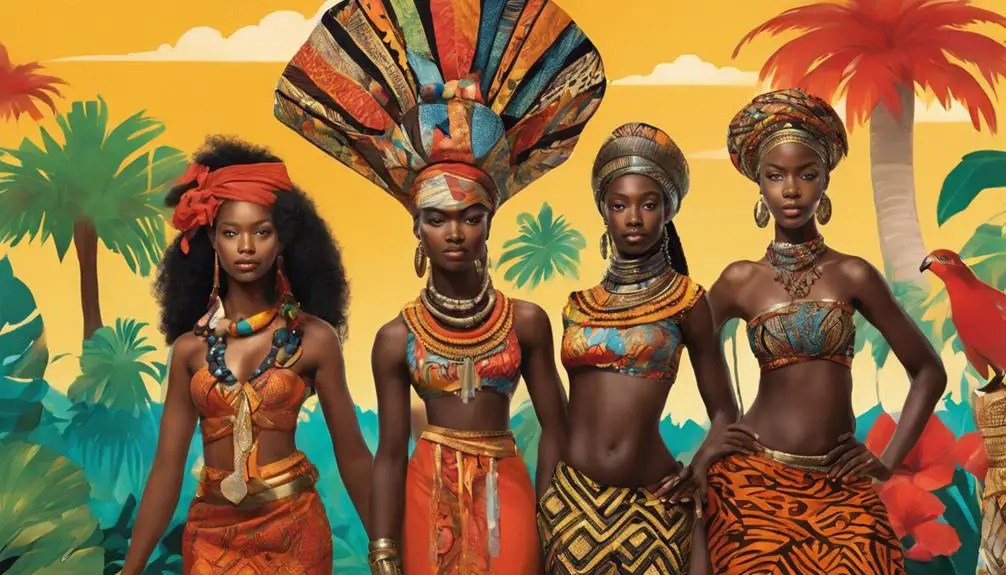
When it comes to the costume design for "The Woman King," inspiration flows from the rich heritage of 19th-century West African clothing, particularly the striking attire of the Agojie warriors. Costume designer Gersha Phillips masterfully captures this cultural essence, showcasing a costume evolution that reflects both authenticity and functionality. Initially, the designs featured baggy pants, but they evolved into more practical wrap skirts, perfectly suited for the film's intense combat scenes.
Phillips employed various design techniques to guarantee the costumes not only look stunning but also allow for ease of movement. The inclusion of stretch-knit fabric is a brilliant choice, catering to the action-oriented nature of the film. You'll notice the intricate details as well, such as the cowry shells integrated into General Nanisca's costume, symbolizing victory and royal gifts, which enhances the cultural significance of the attire.
Additionally, the use of indigo block printing and traditional dyeing techniques creates authentic fabric patterns that echo the rich heritage of the Agojie. This thoughtful approach to design not only honors history but also brings the powerful story of these warriors to life on screen, creating a visual feast for the audience.
Historical Accuracy in Costumes
In crafting the costumes for "The Woman King," the focus on historical accuracy shines through, ensuring that every detail resonates with authenticity. The costume designers dove deep into extensive research on 19th-century West African clothing, particularly the attire of the Agojie warriors. Collaborations with historians were essential, helping clarify wardrobe elements that represent the cultural heritage and historical representation of the Kingdom of Dahomey.
To highlight some key aspects of this dedication to costume authenticity:
- Extensive Research: Designers studied historical texts and artifacts for accurate representations.
- Symbolic Elements: King Ghezo's attire features a crocodile motif, significant in Dahomey tradition.
- Realistic Wear: Costumes show signs of wear and environmental effects, reflecting the warriors' experiences.
Through these efforts, the film delivers an impressive portrayal of the Agojie that not only entertains but also educates viewers about their legacy. With every stitch and fabric choice, the costumes embody the spirit and struggles of these phenomenal warriors, creating a vibrant connection to history that you can't help but admire.
Cultural Elements in Costumes
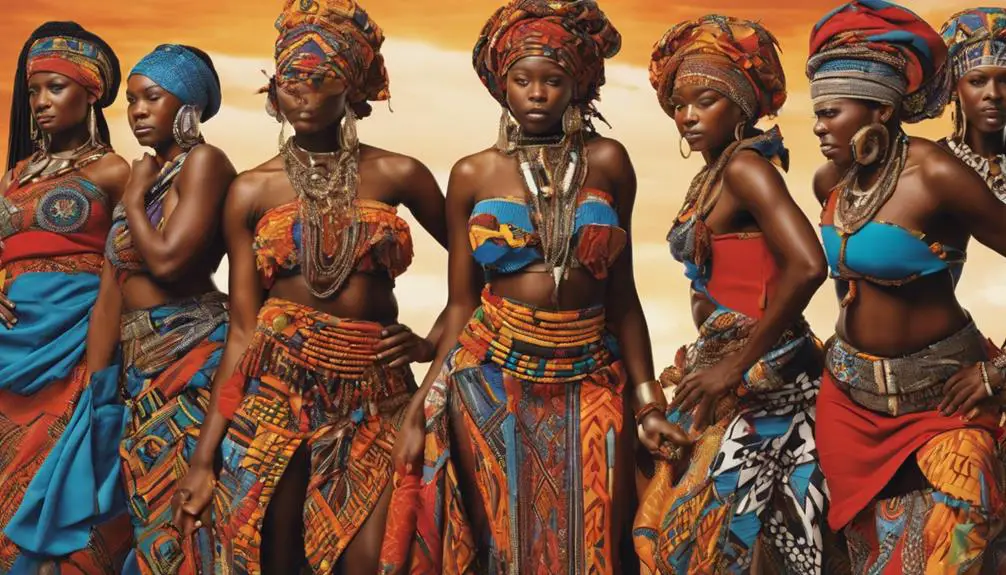
Costumes in "The Woman King" weave together rich cultural elements that deepen the film's narrative. You'll notice how cultural symbolism plays a crucial role, especially through the intricate use of cowry shells. These shells, integrated into the costumes of the Agojie warriors, symbolize victory and serve as cherished gifts from King Ghezo, enhancing the significance of their attire. This attention to detail in costume design mirrors the historical evolution of fashion, similar to how Loewe has transformed over the decades, reflecting craftsmanship and authenticity in their creations vintage Loewe tags. General Nanisca's costume, with its distinctive sash and headpiece adorned with cowry shells, clearly represents her leadership and warrior identity within the ranks.
The film also highlights textile heritage, showcasing traditional indigo block printing techniques that reflect the craftsmanship and importance of local culture. Artisan Musa from Gambia hand-dyed batik cotton, adding authenticity and showcasing local textile traditions that enrich the visual storytelling. Additionally, specific fabrics, like the special strip-weave fabric for Nawi's outfit, emphasize the cultural practices of weaving, mirroring the characters' backgrounds and the established hierarchy among them. Together, these elements create a tapestry of cultural richness, making the costumes not just visually stunning but also deeply meaningful, connecting viewers to the historical and cultural context of the story.
Variations in Warrior Attire
Variations in warrior attire in "The Woman King" vividly illustrate the hierarchy and roles among the Agojie warriors. Each outfit serves as a powerful symbol of warrior identity, showcasing the evolution of costumes that reflect the journey from novice to leader. For instance, General Nanisca's elaborate attire, adorned with intricate gold embroidery, signifies her high rank and authority, while aspiring warrior Nawi's simple two-yard wrap reveals her status as a trainee.
The contrast in designs effectively communicates the warriors' varying levels of experience and authority within the group. Consider these key aspects of the attire:
- Complexity in Design: Nanisca's royal tunics showcase opulence, while Nawi's outfit emphasizes practicality and training symbolism.
- Cultural Craftsmanship: Nawi's fabric, woven in 10-centimeter pieces by skilled artisans, highlights the meticulous craftsmanship involved in costume creation.
- Visual Hierarchy: The differences in attire not only celebrate individual roles but also reinforce the unity and strength of the Agojie as a whole.
This dynamic portrayal of warrior attire in "The Woman King" not only captivates viewers but also enriches our understanding of the Agojie's storied legacy.
Regal Presentation for King Ghezo
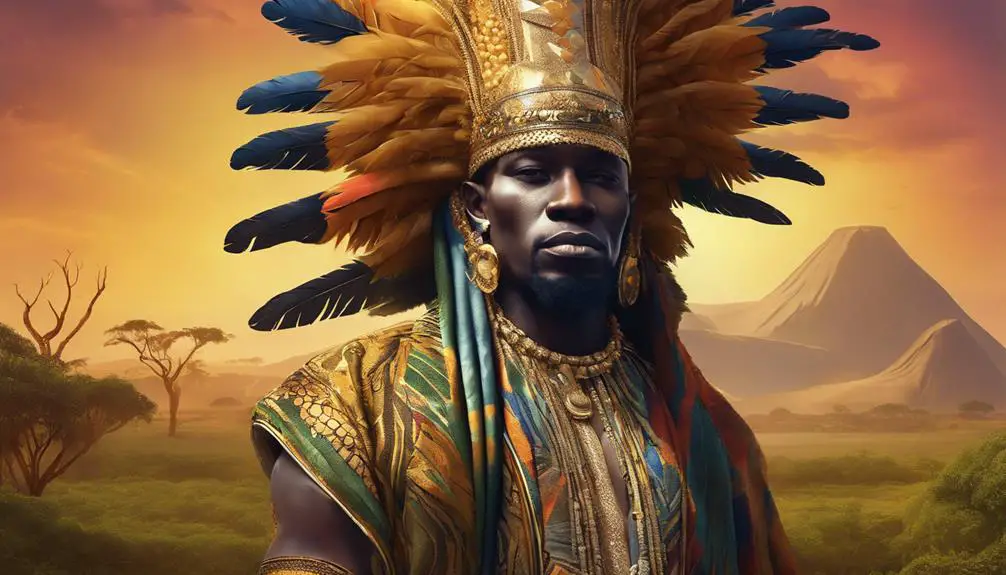
When you look at King Ghezo's outfits, you're immediately struck by the regal design elements that define his character. Each piece, with its intricate metallic embroidery and carefully chosen fabrics, symbolizes his high status and authority within the Kingdom of Dahomey, effectively contrasting with the warriors' attire. The innovative use of materials, like the repurposed Ethiopian bedsheet, not only showcases creativity but also reflects the cultural richness and power dynamics of the 19th-century setting.
Royal Attire Design Elements
To convey the regal presence of King Ghezo, the design elements of his royal attire are meticulously crafted to reflect sophistication and authority. The choice of color palettes plays a pivotal role, utilizing rich and bold hues that signify power and prestige. The fabric selection techniques highlight the resourcefulness of the costume designers, who creatively repurposed materials like an Ethiopian bedsheet into a stunning cream palace outfit, showcasing innovation in historical costume design.
Consider these key aspects of King Ghezo's attire:
- Metallic Embroidery: The intricate embroidery not only enhances the visual appeal but also signifies the king's wealth and status within the Kingdom of Dahomey.
- Elaborate Embellishments: Each decoration serves a purpose, symbolizing the power that King Ghezo wields, making him visually distinct from other characters.
- Contrasting Aesthetic: By designing garments that starkly contrast with simpler outfits worn by others, the filmmakers effectively underscore the hierarchical nature of the narrative.
These carefully chosen elements elevate King Ghezo's royal attire, ensuring it resonates with both historical authenticity and cinematic grandeur.
Symbolism in Costume Choices
Costume choices in "The Woman King" often symbolize the regal stature of King Ghezo, consistently reflecting his authority and leadership. His outfits evolve throughout the film, showcasing a meticulous design process that emphasizes his high status within the Kingdom of Dahomey. The use of fabrics with metallic embroidery not only enhances his royal appearance but also signifies the cultural influences that shape his character identity.
One standout piece, a distinctive cream palace outfit repurposed from an Ethiopian bedsheet, highlights the innovative material sourcing that characterizes the film's costume evolution. Each elaborate embellishment serves a purpose, reinforcing Ghezo's power and presence. The attention to detail in his wardrobe creates a visual narrative that aligns with the historical context of 19th-century Dahomey, making his character feel authentic and compelling.
Collaboration With Artisans
The authenticity and cultural richness of "The Woman King" stemmed from its collaboration with African artisans, who played an important role in the costume design process. This partnership not only guaranteed that the costumes authentically represented the characters' heritage but also celebrated the vibrant artisan techniques unique to various African cultures. By working closely with local craftsmen, the film was able to integrate traditional methods and materials, resulting in stunning handmade fabrics that truly reflect the story's essence.
Here are some key benefits of this collaboration:
- Cultural Authenticity: The costumes are deeply rooted in the traditions and histories of the characters, enhancing the film's narrative.
- Local Economy: By sourcing materials locally and employing artisans, the project supported the local economy, fostering growth and sustainability.
- Skills Development: Hands-on training sessions provided opportunities for artisans to enhance their craftsmanship, guaranteeing the preservation of these crucial skills within the community.
This collaboration not only enriched the visual storytelling but also highlighted the importance of heritage, leaving a lasting impact on both the film and its creators.
Audience Reception and Critique
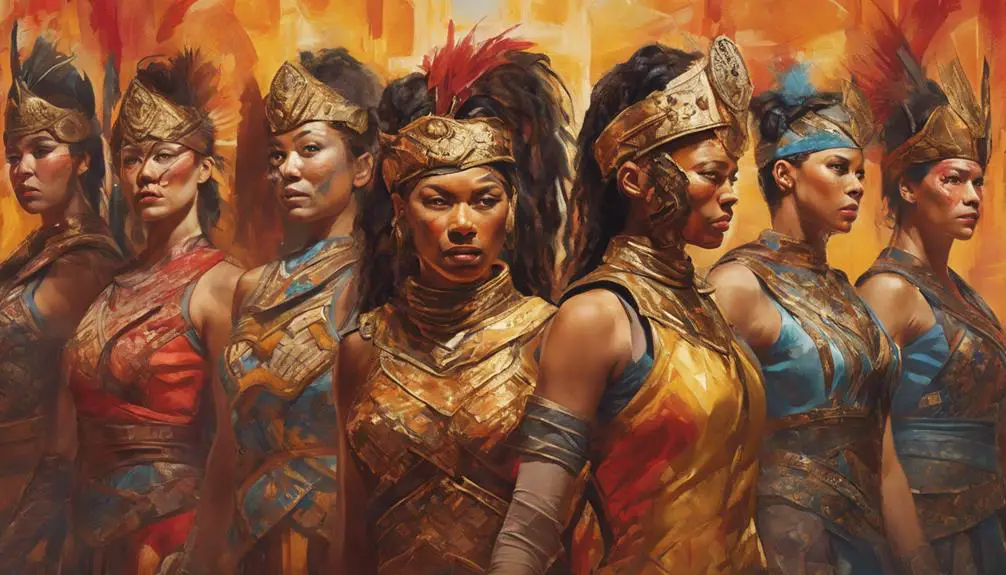
Audience reactions to "The Woman King" have been overwhelmingly positive, particularly regarding the costumes that enrich the film's cultural narrative. Viewers praised the authenticity and intricate details of the outfits, noting how they greatly contributed to the storytelling and emotional depth of the characters. This costume appreciation sparked lively audience engagement on social media, where discussions flourished, highlighting the historical accuracy and creativity displayed in each garment.
Critics, too, engaged in critical analysis of the film's costume design, emphasizing its integral role in the overall success of "The Woman King." The costumes not only enhanced the visual aesthetics but also resonated with audiences, prompting many to return to theaters for repeat viewings. Positive feedback consistently underscored that the costumes were a key element in amplifying the emotional resonance throughout the narrative, allowing viewers to connect more deeply with the characters.
As the film garnered award nominations for its exceptional costume design, it became clear that the intricate work behind the scenes truly captured the essence of the story, making it a memorable cinematic experience.
Visual Impact and Symbolism
Vibrant colors and intricate patterns in "The Woman King" elevate its visual impact, showcasing the cultural richness of the Dahomey Kingdom. The costumes are more than just clothing; they serve as a powerful medium of cultural storytelling and visual storytelling. Each hue and design element plays a vital role in conveying deeper meanings, thanks to color psychology, which evokes emotions and connects you to the characters' journeys.
Consider these key aspects of the film's costume design:
- Symbolism: Elements like cowry shells symbolize victory and protection, reflecting the spiritual beliefs of the Agojie warriors.
- Empowerment: Attires are crafted to represent strength and resilience, visually portraying the warriors' fierce defiance in battle.
- Cultural Pride: The blend of traditional garments with warrior attire highlights a strong sense of identity, merging historical authenticity with cinematic flair.
Frequently Asked Questions
Who Designed the Costumes for the Woman King?
You'll find the costumes were designed by Gabrielle Brady, who focused on costume inspiration from 19th-century West Africa. She guaranteed historical accuracy while enhancing character representation through authentic materials and collaboration with local artisans.
Is Woman King a Lgbtq Movie?
Is "The Woman King" an LGBTQ+ movie? While it doesn't explicitly label itself in this manner, its character dynamics and queer representation within historical context invite interpretations that resonate with diverse audiences, celebrating strength and solidarity among women.
What Country Was Woman King Filmed In?
You'll find "The Woman King" was filmed in South Africa, chosen for its cultural significance and historical accuracy. The diverse filming locations authentically represented the Kingdom of Dahomey, enhancing the film's overall impact.
What Did the Agojie Wear?
You'd be amazed by the Agojie armor! It's not just stunning; it's steeped in cultural significance and historical accuracy. Their attire, a fierce blend of tradition and functionality, empowered them in battle like true warriors.
